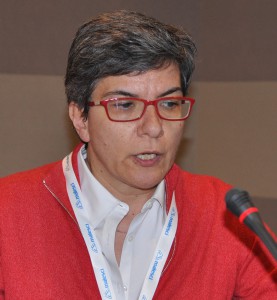
The field of imaging and diagnostics is constantly advancing, with new technologies and innovations regularly being introduced. In this changing environment, how do clinicians ensure they keep up, and that their patients are receiving the right services? In this guest post, Rosa Sicari, co-Editor-in-Chief of Cardiovascular Ultrasound introduces a new ‘How I do it’ article series to help tackle these challenges.
Today echocardiography is one of the most widely used diagnostic tests in cardiology. Largely due to its cost-effectiveness, its high clinical yield, the ability to assess anatomy and function, contractility and coronary flow reserve, and heart valve status, all in the same sitting; and, most importantly, an ease of communication as it is performed by the cardiologists who translate the results into clinical management.
Ultrasound has been recognized since its introduction as a breakthrough technology for its unsurpassed qualities: portability (and more recently miniaturization), wide availability, low cost, safety profile, diagnostic and prognostic yield. These features make it the perfect tool for screening, diagnosis and follow-up studies. The major drawback is the potential for misuse and overuse which is related to its wide availability and the need for appropriate training.
However, I believe that ultrasound has not yet been fully exploited. Echocardiography is largely performed by cardiologists who are just a small segment of the potential users outside of this discipline. Moreover, echocardiography is becoming the perfect tool for out of hospital evaluations and screening programs, due to the development of small and hand-held machines.
Explaining the latest technological advances
Cardiovascular Ultrasound was founded in 2003 by Eugenio Picano, a leading scientist in the field of non-invasive imaging, particularly cardiac ultrasounds. At that time no other publication addressed non-invasive imaging as a new discipline in cardiology.
Echo journals were mostly dedicated to clinical applications with little or no interest in covering topics such as experimental ultrasounds; cost-effectiveness; proofs of concept; or comparisons with other more expensive imaging techniques. The founding idea of the journal was to provide a free space to cover all those topics largely ignored by the main publications in echocardiography. A free space for discussion, criticism and new scientific proposals.
The new ‘How I do it’ article series which we’re introducing in the journal is focused on some ‘hot’ clinical topics, in which experts in the field provide a practical approach and review the main available evidence.
Too often scientific papers, and especially those on newer technologies, do not address the clinical impact and the additive value for the individual patients. This series of six manuscripts is intended to give practical answers through the voice of clinical scientists; ‘super-experts’ in the field.

Ensuring imaging is appropriate for the patient
The first published manuscript addresses appropriateness. Tom Marwick solicits the echo community in complying with appropriateness criteria. Appropriateness – i.e. making sure that the technique used is appropriate for the patient – is the new contemporary imperative to reduce health care costs and the potential downstream risks.
Marwick and Fonseca question the current appropriateness criteria and identify a number of problems, including the evidence base for these criteria and the steps that can be taken to change physician practice.
A restrictive approach to test ordering is difficult to fit to the nuances of clinical presentation and may compromise patient care. The authors argue that after seven years of using the AUC (appropriate use criteria) for echocardiography (transthoracic (TTE) and transesophageal (TEE) echocardiography), there are concerns about the real impact of the AUC on physician ordering behavior.
The literature seems to show a similar proportion of inappropriate testing, in spite of experience, educational campaigns and close follow-up. Moreover, the correlation between appropriateness and clinical impact has not been well studied. Is there an alternative approach able to balance out benefits and risks?
Education, control in point of care, and laboratory-based audit are the best means to obtain appropriateness. Marwick proposes a simplified check-list to be reviewed at point of service, as a prompt to seek clarification from the referring physician.
The implementation and strengthening of appropriateness application to routine clinical practice should be sought. However, it may be difficult to control the problems associated with self-referral and the veracity on the part of ordering physicians.
In the authors’ opinion, the optimal approach requires dialogue between treating physicians, cardiologists and sonographers. The perfect tool has not yet been designed, but a process that flags discussion amongst all the stakeholders at the point of imaging may be more effective than a gatekeeper at the point of ordering the test.
Whilst it is true that most people agree on the need to reduce useless testing, reducing the potential downstream risks and unsustainable costs, it’s also true that there is a long way to go before appropriateness becomes a real imperative in clinical medicine. A strong patient-physician alliance will be important in order to ensure better use of imaging techniques. Such an approach would – one hopes – reduce the chances of medical litigation.
Cardiovascular Ultrasound is designed to be the public scientific arena to answer many of these clinical and practical questions. Echo scientific societies are the best advocate to promote the diffusion and widespread use of echocardiography, and journals have a relevant role but only if they meet readers expectations, to learn, to understand, to know and to obtain ready-to-use information. We have the ambition to meet these needs.
Comments